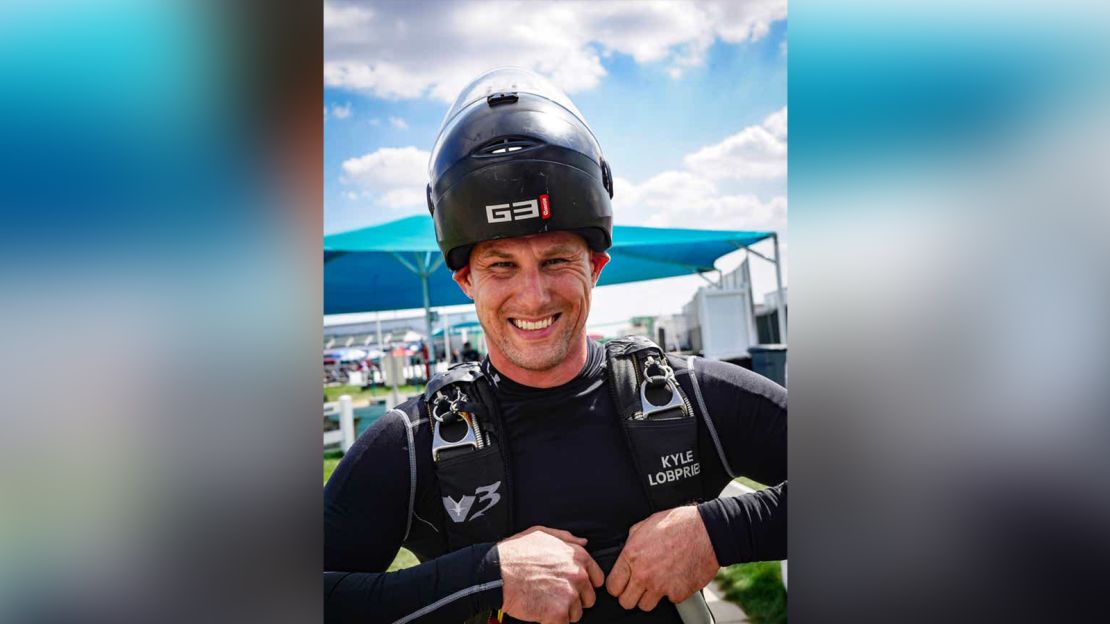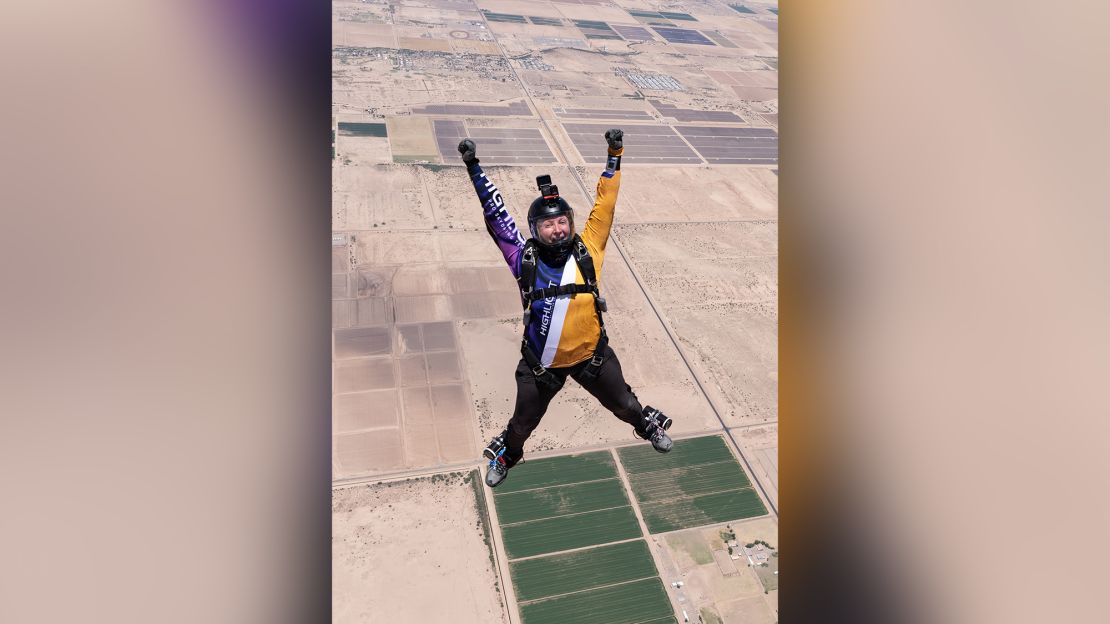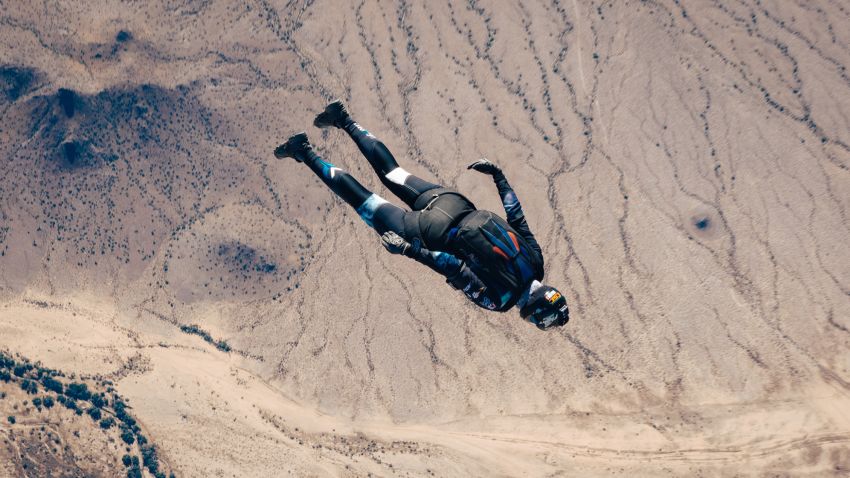The next time you’re in a car traveling along the freeway at 70 miles per hour, see what it feels like when you thrust your hand out of the window – it’s an intense sensation.
But now imagine moving more than four times faster and without the enclosed structure of the vehicle for protection.
That’s what speed skydivers experience every time they drop from a plane and hurtle back down to earth at around 300 miles per hour.
World speed skydiving champion Kyle Lobpries imagines the sensation is what one might experience upon slipping into a wormhole.
Speaking to CNN Sport, the 38-year-old American compared it to the jump to hyperspace in the Star Wars movies “where all the stars get blurred and turn into lines.”

Using only gravity as fuel, speed skydiving is the fastest non-motorized sport in the world. “Those kind of speeds are just a next level of crazy,” British-American Maxine Tate tells CNN Sport.
“I mean, we’re going at speeds faster that Formula One cars,” the female world champion says, “I come down and I can see my hands are physically trembling, and that’s an involuntary physical reaction to the sheer, visceral intensity of the dive.
“I don’t get that from any other skydive. I think it just blows people’s minds.”
A history of speed
Ever since man has been able to ascend into the skies, we’ve only been too keen to throw ourselves back down to earth.
In Paris in 1797, just 14 years after the hot air balloon first took flight, the French aeronaut André-Jacques Garnerin became the first man to ride a parachute back down to the ground.
During the First World War, parachutes gained value as a means of saving pilots from their stricken aircraft, and by World War II, they were being used to facilitate the mass deployment of troops all over the world.
Skydiving emerged as a competitive sport in the 1930s and the first international competition was held in 1951, but it wasn’t until the end of the 1990s that vertical speed was being pursued, making speed skydiving the latest frontier in human flight.
“A lot of people ask me, ‘How do you go fast?’” says Kyle Lobpries, who won the 3rd World Speed Skydiving Championships in 2021. “‘Is it just who’s the heaviest?’ And absolutely not. I’d say that 95 percent of how fast you can go is your skill at staying nice and smooth and going as straight down as possible.”

Having spent 14 years flying Cobra attack helicopters and then fixed-wing aircraft in the military before making a career from jumping out of them, he’s well versed in the mechanics of successful, extreme flight. “Decreasing wobbles and any type of flutter [is] something that even fast aircraft take into consideration. They need to have their parts and pieces not shake.”
It’s hard to find visual documentation of Lobpries traveling at such speeds – he drops so fast that nobody with a camera can keep up with him in freefall.
CNN has seen footage of Maxine Tate, though, dropping head-first towards the ground. Her hands are up by her hips, arms in line with her body while she tries to keep her trailing legs and feet as still as possible.
“You get to a certain speed in the dive where you start to wobble,” she explains. “And you have to push through that wobble, being very relaxed, but still maintaining body form and not reacting to the wobbles. It’s a real mental and physical game.”
At the 2021 World Championships in Siberia, both Tate and Lobpries established themselves as the fastest humans on the planet, and both again were on the top step of the podium at the subsequent US Championships in October.
Their speed is determined as the fastest three-second average in a dive and measured by GPS tracking devices. “It took a while for the community to adopt the GPS scoring system,” noted Lobpries.
“But obviously, the technology is good for it. We use it to guide fighter jets and missiles and bombs, so GPS can guide some pretty fast things, including a human body falling at 300 miles per hour.”
Just how fast can we go?
In 2021, Lobpries set a new world record at 318 mph, while Tate’s top speed was 285 mph, also a world best. Tate says she’d like to break 300 mph – and Lobpries is aiming for 330 mph – but neither of them truly knows where the ceiling might be, or what is even possible.
“I don’t think we have an exact answer on how to go faster,” Tate pondered. “So we’re out there experimenting. Everybody has a different body type, weight and shape. So there’s no clear answers. It’s just about going out there and experimenting and seeing what works for you.”
Skydivers know that thinner air equates to faster flight and further advances in aerodynamic technology will surely fuel even greater speeds.
But unlike other speed sports, there may be a scientific ceiling for these particular athletes: terminal velocity – the theory that the force of the air’s resistance becomes equal to the gravitational pull and hence no further acceleration is possible.
Kyle Lobpries doesn’t believe that’s anything to be concerned about just yet. “There’s a theoretical maximum terminal velocity that each person for their body type and their weight could achieve,” he explained.
“But because there’s so much skill involved in flying your body, I don’t think that anyone has reached that yet, including myself. And we have a lot of upward potential before we decide that the sport is limited by terminal velocities.
“I still think that the skill of flying your body is the main determining factor in who wins.”

The sky is the limit for Tate, who’s driven to excel by proving that anything is possible. There can’t be many athletes who become world champions at anything at the age of 52.
This reporter initially hesitated to ask her age and was relieved to be told, “I positively encourage you to use my age, I think there is a powerful message in that.”
Growing up in Britain, Tate spent 15 years working in corporate finance before an epiphany led her to rethink her priorities. Some 10,000 sky dives later, she’s a free bird, both literally and figuratively.
“I realized that time is the most precious thing to me and long hours and multiple weekends [working] in the city really wasn’t what was important,” she said. “I decided to just hit the reset button and go and do something I knew I was super passionate about. And I don’t regret a minute of it.”
As a female skydiver, she’s also a trailblazer – Tate estimates that only about 15% of the United States Parachute Association membership is women.
“If you see it, you can be it; we really want to show women skydiving and show that you can lead bold and brave lives. It’s a metaphor for what’s possible if you choose to lead a life outside of your comfort zone.”
Tate says that overcoming the fear of jumping out of a plane at 14,000 feet can be transformative and empowering, and she believes that her journey can inspire other women to break free of expectation and stereotype.
Visit CNN.com/sport for more news, features, and videos
“Taking that step outside your comfort zone more regularly leads to a much more intentional life. And that’s really what we’re trying to encourage women and young girls to do: to see what’s possible.”
Hurtling towards the ground certainly won’t be for everyone, even regular skydivers recoil when they hear what Tate and Lobpries are up to. “Hell no, never” is a typical exclamation that they’ll encounter.
But whether it’s in skydiving or in life, Tate’s response will always be the same: “Never say never, is all I can say!”

















